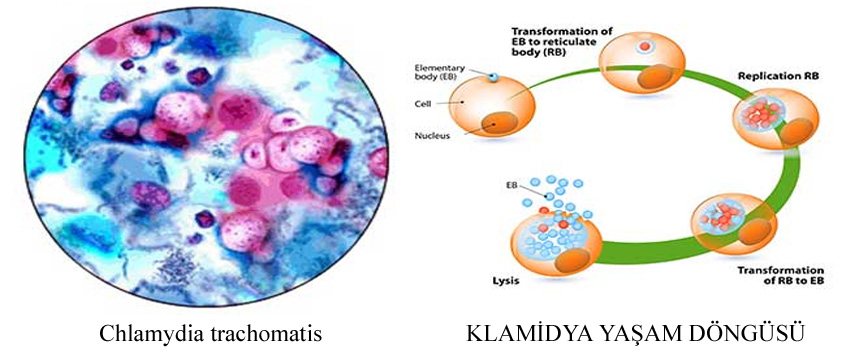What is the Chlamydia Test?

Chlamydia is a sexually transmitted disease that does not show many symptoms, spreads insidiously.
Chlamydia is one of the common sexually transmitted diseases. It has affected 100 million people in the world, and this number is increasing rapidly with new cases. Chlamydia is in the leading position among genital infections, its incidence (gonorrhea) is 3 times higher than gonorrhea.
Chlamydia is a contagious sexually transmitted disease that spreads insidiously and threatens the society due to its long incubation period and very mild symptoms. People who carry the disease can continue to infect others without knowing it.
How is chlamydia transmitted?
The only way of transmission of chlamydia bacteria is sexual intercourse. It is not transmitted by touching, kissing, saliva, syringe, razor blade and blood. Chlamydia is transmitted by vaginal and anal intercourse, although chlamydia can be transmitted through oral sex, although it is rare.
Chlamydia is a very easily transmitted bacterium. The probability of transmission from man to woman in a single relationship is 40%, and the probability of transmission from woman to man is 30%. This shows that men are more likely to transmit this disease.
Especially women under the age of 26 who have unprotected sexual intercourse with more than one sexual partner are at risk for chlamydia infection. Using birth control pills is thought to increase the risk of contracting chlamydia.
Chlamydia is a very contagious bacterium. The probability of male-to-female transmission in a single relationship is 40%, and the probability of female-to-male transmission is 30%. Especially women under the age of 26, with multiple sexual partners or who have recently had sexual intercourse with a new partner, black and low socioeconomic class women are at risk for chlamydia infection. It is claimed that using birth control pills increases the risk.
What are the Symptoms of Chlamydia?
70% of chlamydia infections in women do not show any symptoms. The most common complaints when symptomatic in women are;
- slight yellowish vaginal discharge
- Burning while urinating
- frequent urination
- Burning and itching in the vaginal area
- redness
- wounds on external genitalia
- Swelling and pain in Bartholin’s gland
- pain or bleeding during intercourse
Chlamydia infection in men gives more symptoms, chlamydia symptoms in men;
- discharge from penis
- Burning while urinating
- pain of testicles
- swelling in the testicles
How long is the incubation period?
The incubation period of chlamydia bacteria is 6-14 days. If symptoms of chlamydia infection occur, recent unprotected sexual intercourse should be reviewed.
It is not possible to relapse after chlamydia has been treated. If chlamydia reappears in a treated person, this indicates a new infection.
Chlamydia Test
For the diagnosis of chlamydia, it is necessary to have a “Chlamydia trachomatis DNA test” from a urine sample. The accuracy of this test is close to 100%, but it is an expensive test and may not be performed in every laboratory. There are other tests, but their power to accurately detect chlamydia is not as high as the Chlamydia trachomatis DNA test and they give false positive results at a rate of 50%. Therefore, positive tests may not indicate a definite chlamydia infection; these need to be confirmed by Chlamydia trachomatis DNA testing. Since the reliability of blood tests in the diagnosis of Kalmidia is low, they are not preferred tests.
This test has different names, it is officially called by the following names.
Chlamydia trachomatis culture
Chlamydia trachomatis DNA Probe
Amplified Detection of Chlamydia trachomatis
Direct Antigen Detection of Chlamydia trachomatis (DFA)
The accuracy of the Chlamydia trachomatis DNA PCR test is close to 100%.
The effect of chlamydia infection on female infertility?
Since chlamydia causes an infection without symptoms, it can cause damage to the tubes and uterus in women, and there is an increase in the risks of infertility and ectopic pregnancy due to this damage. The obstruction in the tubes of a woman who has had chlamydia infection causes up to 6% reduction in reproductive ability.
Possible transmission of chlamydia to the baby at birth
Mothers with chlamydia in the cervix have a 60% chance of transmitting the infection to their babies during delivery.
Chlamydia in pregnancy
- premature birth
- early arrival of water due to rupture of membranes
- low birth weight
- It brings risks such as eye inflammation and pneumonia in some babies.
Factors protecting and not protecting from chlamydia
- The most effective way to prevent chlamydia is not to have sexual intercourse at all
- Using a condom during sexual intercourse provides 100% protection from chlamydia.
- Even if there is no vaginal or anal intercourse, chlamydia can be transmitted from the penis and vaginal secretions.
- Contraceptive methods other than condoms do not protect against chlamydia.
- Aspects such as taking care of hygiene, wearing tight pants or cotton underwear do not protect from chlamydia.